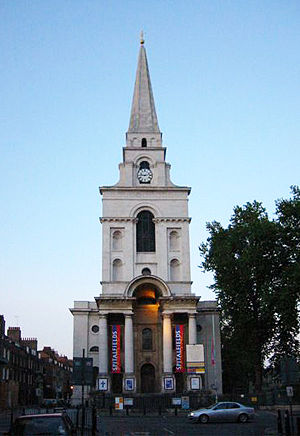The East End of London, also known simply as the East End, is the area of London, England, east of the Roman and medieval walled City of London and north of the River Thames. Although not defined by universally accepted formal boundaries, the River Lea can be considered another boundary. For the purposes of his book, East End Past, Richard Tames regards the area as coterminous with the London Borough of Tower Hamlets: however, he acknowledges that this narrow definition excludes parts of southern Hackney, such as Shoreditch and Hoxton, which many would regard as belonging to the East End. Others again, such as Alan Palmer, would extend the area across the Lea to include parts of the London Borough of Newham; while parts of the London Borough of Waltham Forest are also sometimes included. It is universally agreed, however, that the East End is to be distinguished from East London, which covers a much wider area.Use of the term East End in a pejorative sense began in the late 19th century, as the expansion of the population of London led to extreme overcrowding throughout the area and a concentration of poor people and immigrants. The problems were exacerbated with the construction of St Katharine Docks (1827) and the central London railway termini (1840–1875) that caused the clearance of former slums and rookeries, with many of the displaced people moving into the East End. Over the course of a century, the East End became synonymous with poverty, overcrowding, disease and criminality.The East End developed rapidly during the 19th century. Originally it was an area characterised by villages clustered around the City walls or along the main roads, surrounded by farmland, with marshes and small communities by the River, serving the needs of shipping and the Royal Navy. Until the arrival of formal docks, shipping was required to land its goods in the Pool of London, but industries related to construction, repair, and victualling of ships flourished in the area from Tudor times. The area attracted large numbers of rural people looking for employment. Successive waves of foreign immigration began with Huguenot refugees creating a new extramural suburb in Spitalfields in the 17th century. They were followed by Irish weavers, Ashkenazi Jews and, in the 20th century, Bangladeshis. Many of these immigrants worked in the clothing industry. The abundance of semi- and unskilled labour led to low wages and poor conditions throughout the East End. This brought the attentions of social reformers during the mid-18th century and led to the formation of unions and workers associations at the end of the century. The radicalism of the East End contributed to the formation of the Labour Party, and Sylvia Pankhurst based campaigns for women's votes in the area and organised the first Communist Party in England here.Official attempts to address the overcrowded housing began at the beginning of the 20th century under the London County Council. The Second World War devastated much of the East End, with its docks, railways and industry forming a continual target for bombing, especially during the Blitz, leading to dispersal of the population to new suburbs and new housing being built in the 1950s. The closure of the last of the East End docks in the Port of London in 1980 created further challenges and led to attempts at regeneration and the formation of the London Docklands Development Corporation. The Canary Wharf development, improved infrastructure, and the Olympic Park mean that the East End is undergoing further change, but some parts continue to contain some of the worst poverty in Britain.




Comment
0